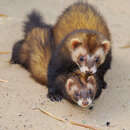Biology
provided by Arkive
Polecats are nocturnal, although activity levels peak at dusk (2). During the winter they become less active and emerge during the day more than they would in summer (2). This opportunistic carnivore takes a great range of prey including rodents, amphibians, rabbits, eggs, birds, and insects (2); individual polecats can take rabbits much larger than themselves (1).
Polecats are solitary and defend a territory from individuals of the same sex (2). Mating occurs between March and May (2), during copulation males grab the female by the neck and drag her backwards and forwards until she becomes limp, at which point he will mate with her (1). A single litter is normally produced, although a second can occur if the first is lost (1). Typically 3-7 young are produced in late May or early June (2). When they reach 4 months of age the young disperse away from the place of birth, and can breed by the next year (2). Whilst dispersing, the polecats are extremely vulnerable (2).
Conservation
provided by Arkive
Deliberate trapping of this species is illegal in the UK without a licence (3). Although the polecat seems to be successfully re-establishing, its spread to some areas, such as Scotland and east England will be very slow; further reintroductions may therefore be suitable in some areas (3).
Description
provided by Arkive
The largest member of the genus Mustela in Britain (3), polecats have weasel-like slender bodies, short legs and a broad head (1). Males are much larger and heavier than females, but other than this size difference they share the same general appearance, with a buff to black coloured coat (4), and a black face with a white mask around it (6). During winter the coat is thick, lustrous and glossy, but in summer it is thinner and appears somewhat faded (1).
Habitat
provided by Arkive
Inhabits lowland areas, usually below 500m (3) and found in marshes, forest plantations, wooded areas, riverbanks, sea cliffs, and sand dunes. They are often associated with farm buildings (2).
Range
provided by Arkive
Distributed throughout much of Europe (1), but absent from Ireland, polecats declined in the early 20th century, reaching their lowest ebb by the 1950s (6). Since the second half of the 20th century, they have been undergoing a recovery, aided by deliberate introductions and the post-myxamatosis recovery of rabbit populations. They currently occur in England as far north as Cheshire, south to Avon and reaching east to Leicester, as well as in most of rural Wales (2). There have also been introductions to several areas of Scotland (2). Confusion with regards to the distribution of this species can arise due to the occurrence of polecat-ferret crosses, which are very similar in appearance to pure polecats (3)
Status
provided by Arkive
Partially protected under Schedule 6 of the Wildlife and Countryside Act, 1981 (3). Listed under Schedule 3 of the Conservation (Natural Habitats etc) Regulations (1994), Annex Va of the EC Habitats Directive, and Appendix III of the Bern Convention. Classified as a species of conservation concern by the UK Biodiversity Action Plan, although not a priority species (5).
Threats
provided by Arkive
Persecution by gamekeepers is the main reason that this species became temporarily extinct in England (4). Polecats were declared vermin during the reign of Elizabeth I, and were perceived as bloodthirsty animals (3). Threats continue today in the form of accidental trapping and secondary poisoning with rodenticides (6). Other threats include road deaths, changes in land-use (such as hedge removal), and crossbreeding with feral ferrets (M. p. furo) (2), which threatens the genetic integrity of the species (4).

